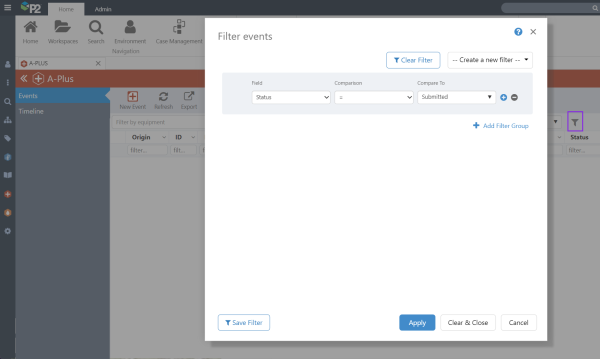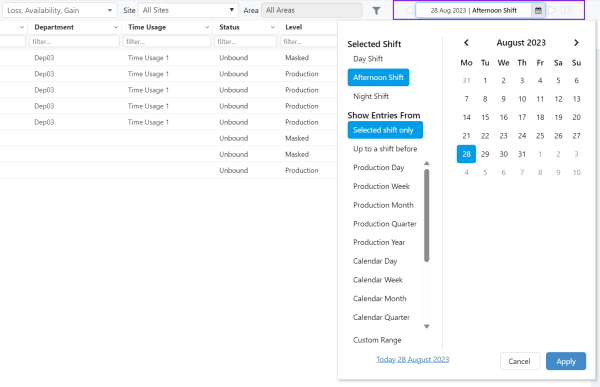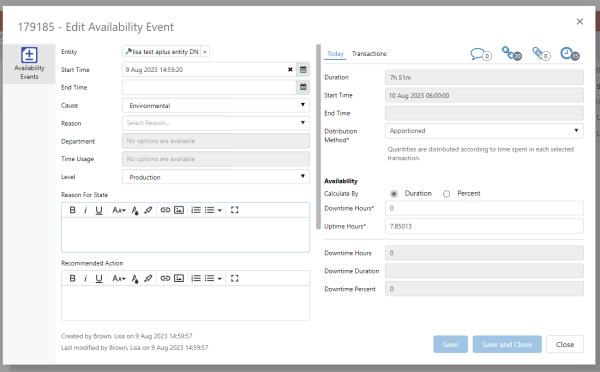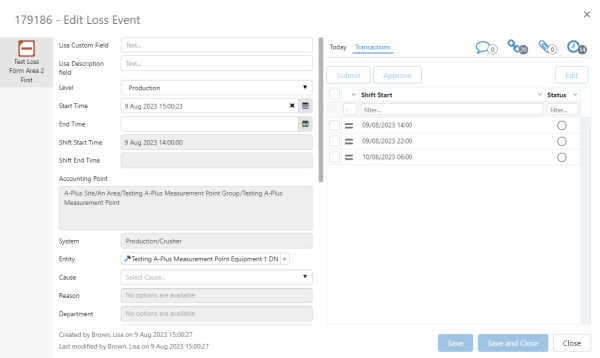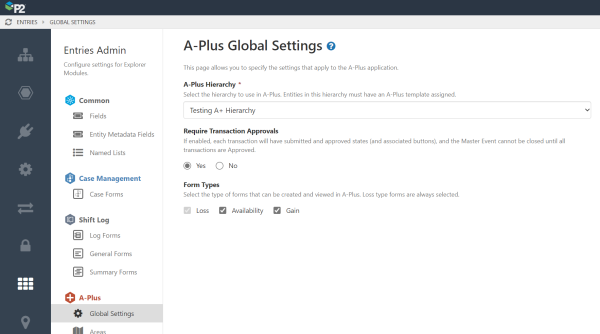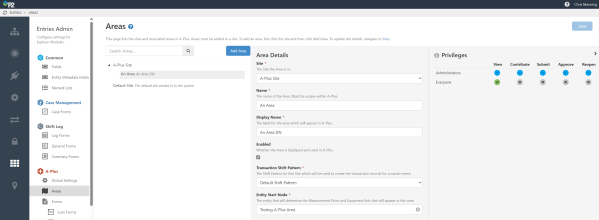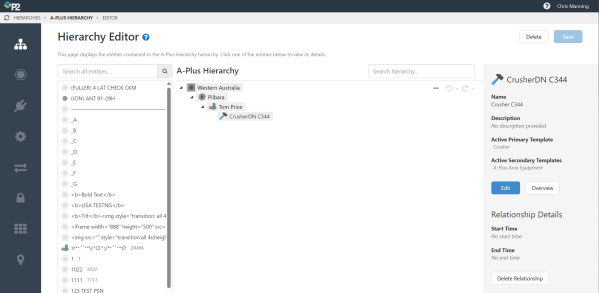ON THIS PAGE:
P2 A-Plus version 4.14 re-invents A-Plus into a true collaboration tool. A-Plus harnesses the power of interconnectivity between Explorer modules, using entries integration with advanced knowledge sharing capabilities.
This version of A-Plus is built on Explorer's Entries subsystem and is directly accessible from within P2 Explorer. A fresh new look has been added to the familiar A-Plus interface and the configuration has been simplified.
Application Overview
The new A-Plus application presents a more streamlined and user-friendly approach than previous versions. It makes use of the Explorer application format already in use by Case Management and Shift Log, and unleashes the power of entries integration tightly coupled with Explorer and Sentinel.
Application Menu
The application menu is always displayed and contains functions applicable to the A-Plus application. From here you can create a new event, refresh the displayed data, or export the displayed events to a .csv file.
Filter Bar
The filter bar is always displayed and is used to restrict events to the selected filter criteria. Filters apply to the Events table, Timeline report, and other custom reports.
The filter bar contains predefined filters, custom filtering, and shift navigation.
Predefined Filters
There are 4 predefined filters: filtering by entity, type of form, site, and area. These are the most commonly used filters and have been surfaced for quick access.
Custom Filtering
Custom filters can be applied to events, to further restrict what is being displayed. Clicking the filter button opens the custom filtering dialog which is also available in Case Management and Shift Log.
Shift Navigation
Our redesigned Shift Navigator makes it easy for you to select the shift you need. First click the date, and then click the shift. Click Apply, and you’re done.
Report Menu
A-Plus offers two built-in reports.
Events: A filterable and groupable table view of events.
Timeline: A filterable Gantt Chart view of events grouped by form type.
A-Plus also offers the ability to build a range of custom reports using the familiar Studio canvas, and includes the following components:
- Charts: Pareto Chart, Waterfall Chart, Embed Trend, Bullet Graph, Box Plot, plus all series charts.
- Layout: Grid Layout, Switch Layout, Precision Layout.
- Shift Log: Case Entry, Log Entry, General Entry, Page Break, Report Form, Report Grid, Report Summary, Summary Table, Single Log Form
- Display: Embed Explorer Page, iFrame, Data Label, Info Button, Status Indicator, Status Tile.
- Tables: Data Table
Events, Forms, and Transactions
In A-Plus 4.14, an event is recorded as a form in Explorer’s Entries subsystem. With this comes the familiar entry dialog, where you can view and update the event and transaction details, add comments and attachments, and see related entries and history of changes.
Events can be entered in A-Plus either manually or automatically by using the Sentinel Detection Engine. An event consists of details about the event (the form and fields) plus information about the amount of downtime or uptime (the transactions).
All events have a least one transaction, which corresponds to the amount of time the event spends in a shift. If an event spans two or more shifts, transactions are automatically created at each shift boundary.
Simplified Administration
 A-Plus back-end administration and configuration is done mainly in P2 Server Management, with allocation modelling done in the A-Plus Admin Tool.
A-Plus back-end administration and configuration is done mainly in P2 Server Management, with allocation modelling done in the A-Plus Admin Tool.
There are 3 main sections in Server Management that are relevant for A-Plus:
-
 Hierarchies: This is where you create entity hierarchies to be used in A-Plus.
Hierarchies: This is where you create entity hierarchies to be used in A-Plus. -
 Entities: This is where you declare the entities to be used in A-Plus by assigning specific A-Plus templates.
Entities: This is where you declare the entities to be used in A-Plus by assigning specific A-Plus templates. -
 Entries Admin: This contains the main A-Plus Forms and Settings configuration.
Entries Admin: This contains the main A-Plus Forms and Settings configuration. -
 Sites: This is where you can configure the sites and shift patterns which relate to Areas in A-Plus.
Sites: This is where you can configure the sites and shift patterns which relate to Areas in A-Plus.
The Admin Tool is used for establishing the database connection and administering the allocation model. In future releases, these functions will be moved into Server Management.
A-Plus Global Settings
Global Settings apply to the entire A-Plus application. This is where you select the main hierarchy to use, the types of events that can be created, and whether to enable an approval workflow for transactions.
A-Plus Sites & Areas
A-Plus allows you to define Areas on a per-site basis. For each site, you specify the details of the site (name, description, etc), shift and swing patterns, and reporting periods.
In A-Plus admin, you can add areas to a site, and apply different privileges per role.
Forms & Fields
A Form defines both the type of events that will be created, and the properties or fields that the events will contain. Forms can be:
Loss Event: Loss is the incomplete utilisation of a piece of equipment, or a lost opportunity for production. While it may be possible to assign an actual cost of amount, the base unit for loss is time.
Availability Event: A quantifiable time frame when a measurement point is not working or not working to an appropriate proportion of design capacity. Availability events can be a precursor to loss events. Availability of a measurement point is an opportunity.
Gain Event: A Gain occurs when production exceeds capacity. It is rare for an equipment to have a gain event.
Loss, Gain, and Availability events all have the same set of default system fields associated with them. In addition to these, an administrator can add further fields as required. The default fields are:
|
System Fields |
Standard Fields |
A-Plus Fields |
|
|
Created By Created Date ID Last Modified By Last Modified |
Entity Start Time End Time Duration Site Shift Start Time Shift End Time |
Cause Reason Department Time Usage Level Reason for State Recommended Action Potential Impact Accounting Point System |
Master Entry ID Status Origin Area Measurement Point Group Measurement Point Production Stream Source System ID Source Entity Name |
Hierarchy
Hierarchies are constructed in Server Management, and will automatically appear in the application when entities in the hierarchy are assigned an A-Plus template as a secondary template.
Simplified Installation
The A-Plus installer activates the A-Plus templates and configuration in Server Management, and installs the Admin Tool. There is no need for a separate database as A-Plus is now unified with Explorer. Entities and Hierarchies in Explorer are now simply a part of A-Plus, without needing to be especially imported. There is no need for separate logins as A-Plus now uses Explorer security.
Explorer Compatibility
P2 A-Plus 4.14 is certified compatible with P2 Explorer 4.14. A-Plus 4.14 is not compatible with earlier versions of P2 Explorer.
Fresh Installation
A-Plus 4.14 is installed with P2 Explorer 4.14. For instructions, refer to the P2 Explorer 4.14 Installation Guide.
Upgrade Process
P2 will work with existing customers in order to facilitate migration to A-Plus 4.14. Please contact P2 Customer Support or your Account Manager to start this process.




